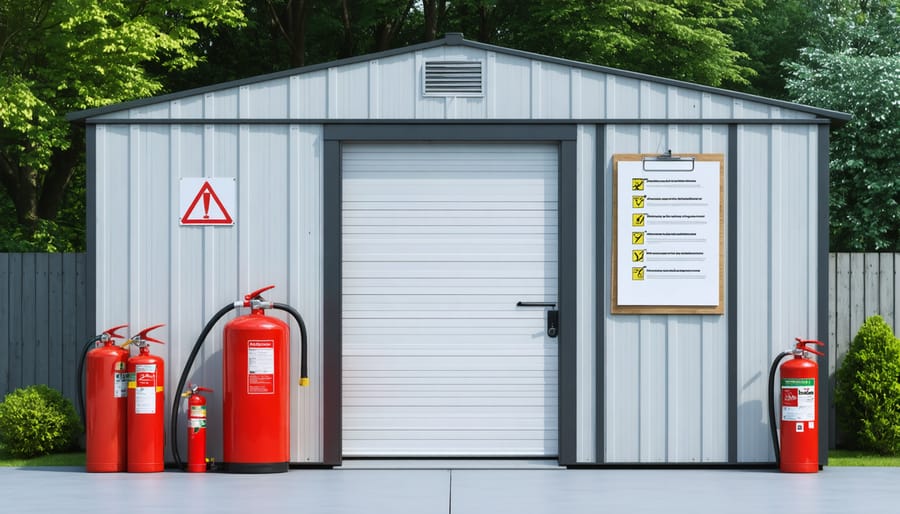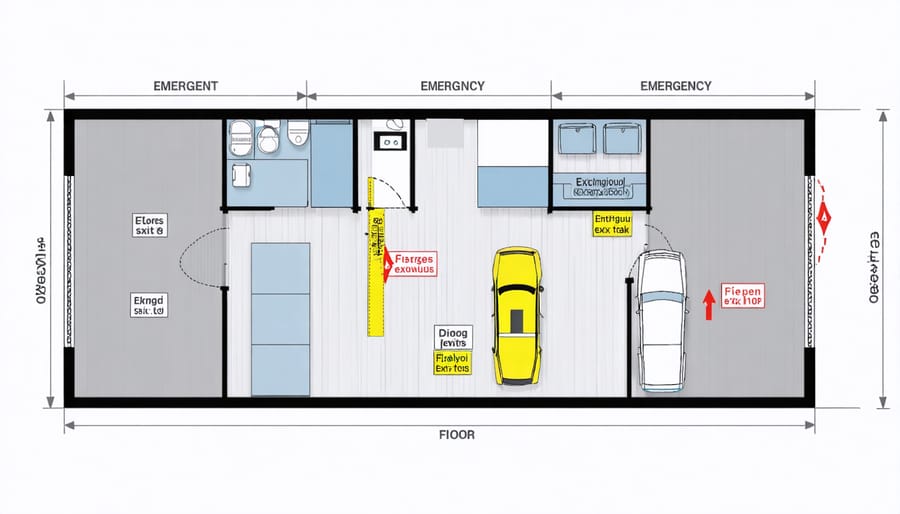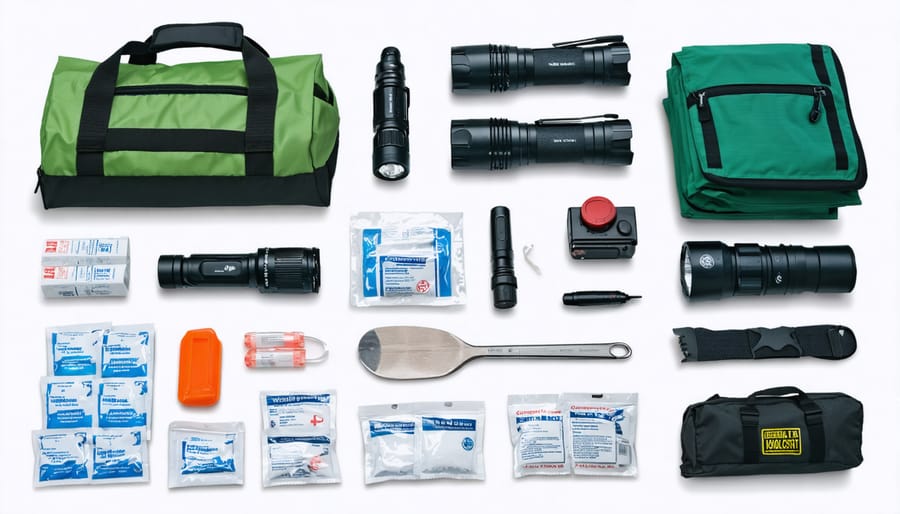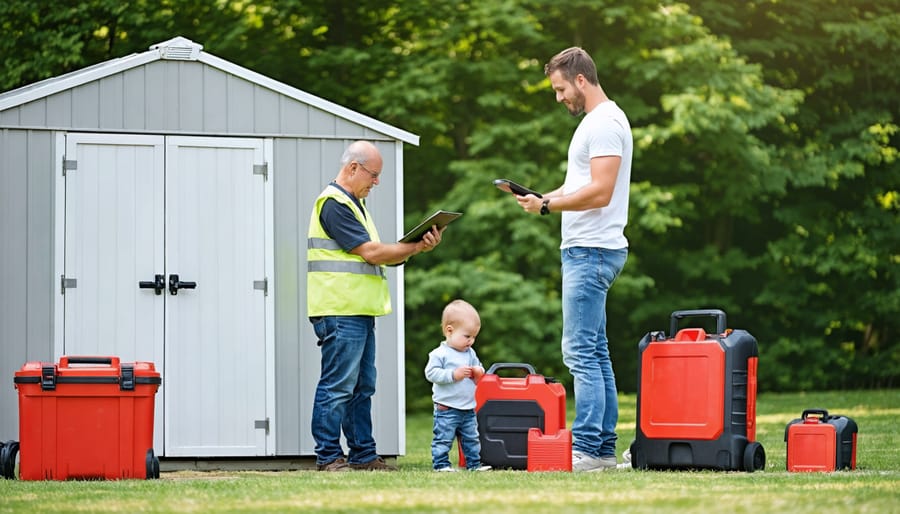OSHA-Approved Emergency Plan That Keeps Your Shed and Family Safe

Emergency preparedness isn’t just about compliance – it’s about protecting lives and safeguarding your property when disaster strikes. OSHA’s emergency preparedness guidelines provide a crucial framework for homeowners to develop comprehensive safety protocols for their storage structures and living spaces. Creating an effective emergency response plan requires careful consideration of potential hazards, clear communication procedures, and regular maintenance of safety equipment.
Transform your storage shed into a safety-conscious space by implementing OSHA’s recommended emergency preparedness measures. Start with a thorough risk assessment to identify potential hazards like fire risks, chemical storage dangers, and structural vulnerabilities. Install appropriate safety equipment, including fire extinguishers, first aid kits, and emergency lighting systems. Establish clear evacuation routes and ensure all family members know exactly what to do during an emergency.
Regular safety drills, equipment maintenance checks, and updated emergency contact information form the backbone of a robust preparedness strategy. By following OSHA’s guidelines while adapting them to your specific needs, you’ll create a safer environment that protects both your family and your valuable belongings.
Essential OSHA Safety Requirements for Your Storage Shed
Emergency Exit Requirements
Emergency exits are crucial for shed safety and must meet specific OSHA requirements. Proper door placement is essential, with exits needing to remain unobstructed and easily accessible at all times. Each exit should be clearly marked with illuminated signs and equipped with emergency lighting that activates during power failures.
For standard storage sheds, at least one emergency exit is required, but larger structures may need multiple exits based on occupancy and floor space. Exit doors must swing outward and be equipped with panic hardware that allows quick escape during emergencies. The path to exits should be kept clear of stored items, with a minimum width of 28 inches for safe passage.
Regular maintenance of exit doors, including checking hinges, handles, and lighting systems, ensures they’ll function properly when needed. Consider installing battery backup systems for exit signs to maintain visibility during power outages.

Fire Safety Standards
Fire safety is a critical component of emergency preparedness, requiring specific measures and equipment to protect both people and property. Every storage area should be equipped with ABC-rated fire extinguishers, placed in easily accessible locations and inspected monthly. Smoke detectors must be installed according to local building codes, typically with at least one detector per enclosed space.
Emergency exits need clear marking with illuminated signs, and pathways leading to these exits should remain unobstructed at all times. Fire-resistant storage containers are recommended for flammable materials, with proper labeling and separation from heat sources.
Regular maintenance checks should include testing emergency lighting systems, ensuring fire doors close properly, and keeping ventilation systems clear of debris. Create a designated outdoor meeting point and post emergency contact numbers in visible locations. Remember to train all regular users on proper fire extinguisher operation and evacuation procedures.
Make sure to document all fire safety measures and maintain detailed inspection logs for compliance purposes.
Creating Your Shed Emergency Action Plan
Risk Assessment Checklist
Conducting a thorough risk assessment is crucial for effective emergency preparedness. Start by walking through your property and storage areas, noting potential hazards like flammable materials, electrical equipment, and chemical storage. Create a detailed checklist that includes natural disaster risks specific to your location, such as floods, earthquakes, or severe storms.
Pay special attention to entry and exit points, ensuring they remain clear and accessible. Check that fire extinguishers and first aid kits are properly maintained and easily reachable. Evaluate your lighting systems, including emergency backup options, and verify that all safety signage is visible and up to date.
Consider vulnerabilities in your security system, including locks, alarms, and surveillance equipment. Document the location of utility shutoffs and ensure family members know how to operate them. Review your insurance coverage to confirm it adequately protects against identified risks.
Update your assessment checklist seasonally or whenever you make significant changes to your storage setup. This proactive approach helps identify potential problems before they become emergencies.
Emergency Contact Information
Maintaining an up-to-date emergency contact list is crucial for effective emergency preparedness. Create a comprehensive list including local emergency services, utility companies, and key personnel. Post this information in easily visible locations and ensure it includes phone numbers for fire departments, police, hospitals, and poison control. Keep digital and physical copies readily available, and update the list quarterly or whenever contact information changes. Include alternative contact methods like email addresses and cell phone numbers, and consider creating a phone tree system for efficient communication during emergencies. Store one copy in your emergency kit and another in a weather-resistant location near your main entrance. Remember to include out-of-state contacts who can serve as central points of communication during local emergencies.
Evacuation Procedures
A well-planned evacuation route is crucial for ensuring everyone’s safety during emergencies. Start by creating clear, unobstructed pathways from your storage area to designated safe zones. Mark these routes with reflective signs and ensure they remain free from clutter and stored items at all times.
Establish primary and secondary exit routes from your shed or storage structure, considering that your main exit might become blocked during an emergency. Post easy-to-read evacuation maps showing these routes, and make sure all family members know where to find them.
Create a designated meeting point a safe distance from your storage structure where everyone should gather after evacuation. This spot should be easily accessible and away from potential hazards or emergency vehicle access points.
Practice your evacuation procedures regularly with family members, timing how long it takes to safely exit and meet at the designated spot. During these drills, test emergency lighting and ensure all exit doors open easily. Remember to account for seasonal changes that might affect evacuation routes, such as snow accumulation or fallen leaves.
Keep essential emergency supplies near exit points, including flashlights and basic first aid kits, to grab quickly during an evacuation.
Emergency Equipment and Supplies

First Aid Essentials
A well-stocked first aid kit is essential for any emergency preparedness plan. Start with a durable, waterproof container that’s easily accessible and clearly marked. Stock it with basic supplies including adhesive bandages in various sizes, sterile gauze pads, adhesive tape, scissors, and latex-free gloves. Include antiseptic wipes, antibiotic ointment, and burn treatment supplies for wound care.
Don’t forget essential medications like aspirin, antihistamines, and hydrocortisone cream. Keep an emergency blanket, instant cold packs, and a basic first aid manual in your kit. For workplace settings, ensure you have eye wash solution and specific items required by OSHA guidelines based on your facility’s needs.
Store your first aid supplies in a cool, dry place away from direct sunlight. Check expiration dates quarterly and replace items as needed. Keep a list of emergency contact numbers inside the kit, and make sure all family members or employees know where to find it. Consider creating multiple kits – one for your home, workplace, and vehicle to ensure help is always within reach.
Emergency Tools and Equipment
Every emergency-ready shed should be equipped with essential tools and equipment to handle various situations effectively. Start with a well-stocked first aid kit containing bandages, antiseptics, and basic medical supplies. Keep flashlights with fresh batteries and backup power sources, including portable chargers and emergency radios, readily accessible.
Include basic tools like a multi-tool, wrench set, and heavy-duty scissors for quick repairs or evacuation needs. Store emergency blankets, waterproof matches, and a supply of non-perishable food and water. Don’t forget personal protective equipment (PPE) such as safety goggles, work gloves, and dust masks.
For weather-related emergencies, maintain items like snow shovels, salt or sand for ice, and tarps for temporary shelter. A well-organized tool box should contain essential repair items: duct tape, rope, zip ties, and basic hardware. Consider adding a portable generator, properly stored fuel, and extension cords for power outages.
Label all equipment clearly and check regularly to ensure everything remains in working order. Create an inventory list and update it seasonally to maintain preparedness.
Maintenance and Training
Monthly Safety Inspections
Regular monthly safety inspections are crucial for maintaining a secure and compliant emergency preparedness plan. Use this simple checklist to ensure nothing is overlooked:
– Check all emergency exits and pathways for obstructions
– Test emergency lighting and backup power systems
– Verify first aid kits are fully stocked and supplies haven’t expired
– Inspect fire extinguishers for proper pressure and placement
– Ensure emergency contact information is current and visible
– Test smoke detectors and carbon monoxide alarms
– Review ventilation systems and air quality controls
– Check that emergency signage is clearly visible and undamaged
– Verify communication systems are functioning properly
– Inspect storage areas for proper chemical storage and containment
Document all findings and address any issues immediately. Set calendar reminders for these inspections to maintain consistency and create a safer environment for everyone.

Family Safety Training
Preparing your family for emergencies starts with clear communication and regular practice. Begin by creating a family meeting point outside your home and an alternate location in case the first isn’t accessible. Teach children how to dial emergency numbers and ensure everyone knows where important documents and emergency supplies are stored.
Conduct monthly family drills that simulate different emergency scenarios, such as fires, severe weather, or medical emergencies. Make these practice sessions engaging and educational rather than frightening, especially for younger children. Create simple, age-appropriate checklists that family members can easily follow during emergencies.
Consider special needs within your family, including elderly relatives, pets, or family members with disabilities. Assign specific roles to capable family members during emergencies, such as helping younger siblings or gathering emergency supplies. Update your training regularly as family circumstances change and maintain open dialogue about safety procedures.
Emergency preparedness isn’t a one-time task but an ongoing commitment to safety and security. By following OSHA guidelines and maintaining a comprehensive emergency plan, you can better protect your property, family, and belongings. Remember to review and update your emergency procedures at least annually, accounting for any changes in your storage needs, local regulations, or environmental conditions.
Make it a habit to conduct regular drills with family members, ensuring everyone knows their role during an emergency. Keep emergency contact numbers visible and accessible, and maintain an up-to-date inventory of stored items. Check safety equipment monthly, replace expired materials promptly, and address any structural concerns immediately.
Your dedication to emergency preparedness today can make a crucial difference when unexpected situations arise. By staying proactive and vigilant, you’re not just meeting OSHA requirements – you’re creating a safer environment for everyone who uses your storage space. Take time each season to reassess your emergency plans, making adjustments as needed to ensure optimal safety and peace of mind.

